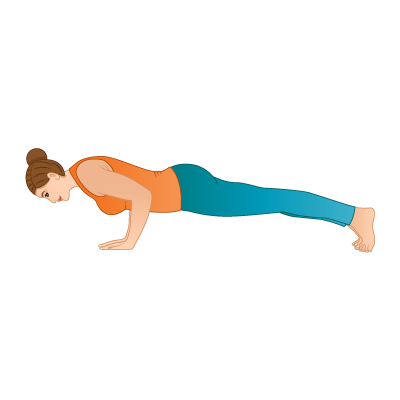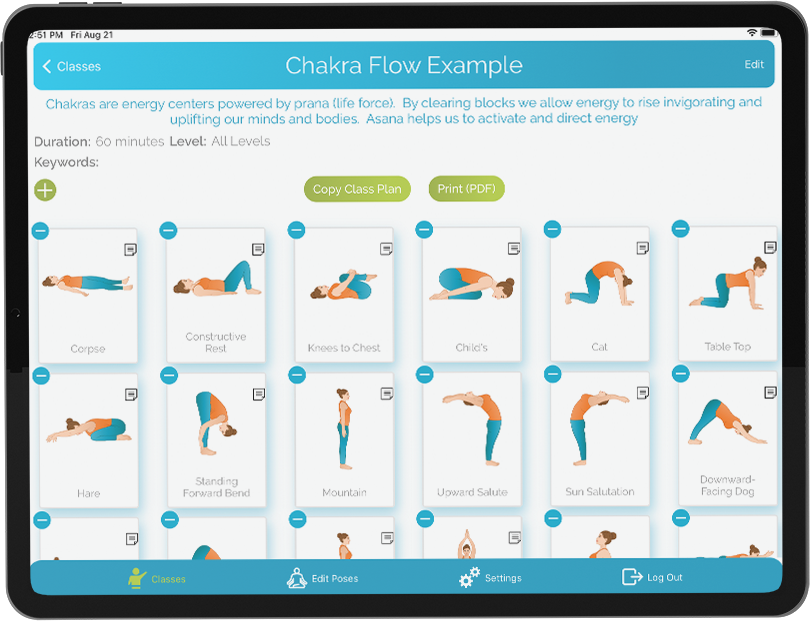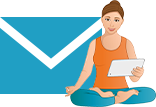7 Hatha Yoga Pradipika Postures for Your Next Yoga Class
February 1, 2023 | 10 min read
Hatha Yoga Pradipika (or Hathapradipika) is a 15th-century Indian Sanskrit text on Hatha yoga, written by an ancient Indian sage Svatmarama. Not much is known about Svatmarama’s life or historical context, but Hathapradipika, alongside the Gheranda Samhita and the Shiva Samhita, is considered one of the most important texts on the practice of Hatha yoga.
The text serves as a manual for practitioners of Hatha yoga, providing instructions on various asanas (yoga postures) in Lesson I (Asana), satkriyas (purification techniques) and pranayama (breathing techniques) in Lesson II (Kumbhaka), mudras and bandhas in Lesson III (Mudra), and meditation in Lesson IV (Samadhi or Nadanusandhana).
The term “Hatha” is composed of the two syllables “Ha” and “Tha”, of which the former means the sun and the latter the moon. Hatha yoga is often described as a union of these two.
Hatha Yoga Pradipika is one of the outstanding Hatha yoga texts which fully describes the eight well-known varieties of Pranayama. Svatmarama explicitly mentioned the opinion that all impurities in the nadis can be removed only by the practice of Pranayama. However, in this article, we will focus on yoga poses (or asanas) that Svatmarama writes about in the first part (Lesson I) of his work.
Svatmarama describes Hatha as a monastery for those who are afflicted by unlimited suffering; and for those who are engaged in the practice of all kinds of yoga, Hatha yoga is the supporting tortoise.
Hatha Yoga Pradipika Asanas (Postures)
Asana (yoga posture) is the first component of Hatha yoga. It brings practitioners physical but also mental steadiness, health, and a feeling of lightness. There are fifteen different asanas mentioned and described in Lesson I of Hathapradipika.
Svatmarama noted that there are eighty-four asanas that have been enumerated by Shiva (there is no available text that describes them and the number might be “legendary” or present an “innumerable” amount of asanas), with four of them being the most important.
In this article, we will cover seven yoga postures you could incorporate into your next yoga class.
1. Gomukhasana – Cow Face pose

You can enter Gomukhasana or Cow Face asana by placing the right ankle by the side of the left hip, and the left ankle by the side of the right hip. From the front, this imitates the shape of a cow’s head, thus the name of the posture.
The benefits of Gomukhasana include sciatica and stiff shoulder healing, the posture helps with high blood pressure and bad posture because it elongates the spine. Reproductive organs are toned and massaged and kidneys are stimulated with regular practice. You should see a reduction in stress and anxiety. Your back muscles will strengthen, as well as muscles of ankles, hips, thighs, shoulders, triceps, inner armpits, and chest.
The full position might be too intensive for some, but do not worry because there are several modifications and variations available.
All information about the pose: visualizations, technical comments, benefits, tips, contraindications, modifications, variations, and counter poses can be found on our yoga pose directory page for Gomukhasana, the Cow Face posture.
2. Paschimottanasana – Seated Forward Bend pose

You can enter Paschimottanasana or Seated Forward Bend asana by stretching both legs straight on the ground and holding with the arms the two big toes. You should stay in this position with your forehead placed, or heading towards your knees.
The benefits of Paschimottanasana include stretching the entire back of the body- calves, hamstrings, back, and neck. This forward bend also calms the nervous system. Paschimottanasana is beneficial for digestive organs and stimulates the kidneys. It should increase the blood flow and will get your lower energy centers in the body to induce a good night’s sleep. This asana can also offer relief during menopause and menstrual discomfort.
All information about the pose: visualizations, technical comments, benefits, tips, contraindications, modifications, variations, and counter poses can be found on our yoga pose directory page for Paschimottanasana, the Seated Forward Bend posture.
3. Kurmasana – Tortoise pose

You can enter Kurmasana asana by pressing the anus with two heels, with ankles reverted, and remaining well-balanced in the position. This is a traditional, Hatha Yoga Pradipika version of this asana. In modern days, Kurmasana is called a Tortoise pose and looks different. In this article, and for our practice ideas, we will use a modern, Tortoise pose variation.
The benefits of Kurmasana include stretching of the legs, back, shoulders, and chest. Back and spine issues should also be improved and healed, while back muscles lengthened. The posture helps to spread out both shoulders and hips.
All information about the pose: steps, teacher queues, contraindications, modifications, variations, and counter poses will be available on our yoga pose directory page for Kurmasana, the Tortoise posture.
4. Dhanurasana – Full Bow pose

You can enter Dhanurasana or Full Bow pose by holding the two toes alternately with the two hands, pulling the toes from the back side up to the corresponding ears, and assuming the shape of a stretched bow.
The benefits of Dhanurasana include a strengthening of back and leg muscles, realigning of the spinal column, improved posture as well as improved flexibility of back, shoulders, and hips. This yoga pose also stimulates spinal nerves, stretching back ligaments and muscles; massages the liver, abdominal organs, pancreas, and adrenal glands. Dhanurasana should also relieve gastrointestinal disorders.
All information about the pose: visualizations, technical comments, benefits, tips, contraindications, modifications, variations, and counter poses can be found on our yoga pose directory page for Dhanurasana, the Full Bow posture.
5. Matsyendrasana – Half Lord of the Fishes pose

You should enter Matsyendrasana or Half Lord of the Fishes pose by placing the right foot at the root of the left thigh, encircling the right knee by the left leg, holding the two feet by the opposite hands, and twisting the body.
The benefits of Matsyendrasana include stretching and toning of back and shoulder muscles, as well as lengthening and energizing the spine. Matsyendrasana massages and tones abdominals, and relieves digestive problems. This pose also aids the function of the liver, kidney, and adrenal glands.
All information about the pose: visualizations, technical comments, benefits, tips, contraindications, modifications, variations, and counter poses can be found on our yoga pose directory page for Matsyendrasana, the Half Lord of the Fishes posture.
6. Bhadrasana – Gracious or Auspicious pose

You should enter Bhadrasana or Gracious (Auspicious) pose by placing the two heels under the scrotum on either side of the perineum. The left heel on the left side and the right one on the right side, and firmly holding with hands the feet which are made to touch the sides. You should remain steady in this posture.
The benefits of Bhadrasana include stretching the thighs, legs, and back, as well as improving the body posture. Bhadrasana provides relief in acidity, gastritis, constipation, and asthma. The pose also regulates the functioning of the thyroid gland and abdominal and reproductive organs. This is an excellent asana for meditation and is beneficial for spiritual purposes.
All information about the pose: steps, teacher queues, contraindications, modifications, variations, and counter poses will be available on our yoga pose directory page for Bhadrasana, the Gracious (Auspicious) pose.
7. Savasana – Corpse pose

You should do Savasana at the end of every yoga class. Savasana is done by lying supine on the ground like a corpse. Stay in this position for 8-10 minutes and allow students to calm their breath and withdraw their senses inside the body. A short guided meditation or calm background music is also welcome.
If there is less time available at the end of the class, you could instruct people to take a deep breath and exhale with a sound through the mouth. Repeat this three times at the beginning of Savasana and let students rest for a few minutes. My teacher calls this “espresso” Savasana.
Savasana is used for stress release and deep relaxation. It calms the nervous system and is beneficial for insomnia, headaches, and pain relief. The posture also helps to lower high blood pressure.
All information about the pose: visualizations, technical comments, benefits, tips, contraindications, modifications, variations, and counter poses can be found on our yoga pose directory page for Savasana, the Corpse posture.
Practicing Hatha yoga and its asanas can bring many benefits to one’s physical, mental, and emotional well-being. The practice of yoga postures can help to stretch and tone the muscles, improve posture and alignment, and increase circulation. I hope this article will inspire you for your future yoga classes and to explore the Hatha Yoga Pradipika text in more detail.
Looking for more inspiration for your next yoga class? YogaClassPlan sequence builder gives you access to 7000+ shared class plans in your hands. You can create your own completely new class sequences by choosing from 500+ pose illustrations. Simply drag and drop poses to create your routine, add class plan details such as duration and level, and share the class plan with your students. Sign-up for a 15-day YogaClassPlan free trial today.
About the author:
I’m Matija, a seasoned digital marketing professional working in the industry since 2011. I hold a master’s degree in information technology, blending technical expertise with marketing finesse. I’m also a certified yoga teacher with a passion for mindfulness. I’ve been practicing yoga since 2013 and started teaching in 2022. This unique combination of skills reflects my commitment to holistic growth and helping others achieve their goals. Explore my insights on digital marketing and the transformative power of yoga in my blog posts on YogaClassPlan.
Featured Photo by Jared Rice on Unsplash.
Posted in Opinion, Teaching Resources, Teaching Tips




